Abstract
Cis-urocanic acid (cis-UCA), which is formed from the naturally occurring trans-isomer on ultraviolet (UV) irradiation, has been suggested as a photoreceptor for and mediator of the suppressive effects of UV irradiation on systemic immune responses. Trans-UCA is located predominantly in the stratum corneum, and the extent of isomerization to cis-UCA may be analysed by high-performance liquid chromatography (HPLC) of skin extracts. Such an analysis is not suitable for other tissues. In this study a murine monoclonal antibody to cis-UCA was prepared and tested by ELISA using UCA isomers conjugated to protein as antigens. The interaction of the antibody with structural analogues of UCA was assessed by competitive inhibition ELISA which indicated that the antibody had a high specificity for cis-UCA. Screening of sera at various times after UVB irradiation of mice by competitive inhibition ELISA using the monoclonal antibody showed that cis-UCA was present, probably in an unbound form, for at least 2 days after the exposure. Thus, cis-UCA produced in the epidermis following UVB irradiation reaches the serum a few hours later. The implications of this finding for the generation of suppressed immune responses are discussed.
Full text
PDF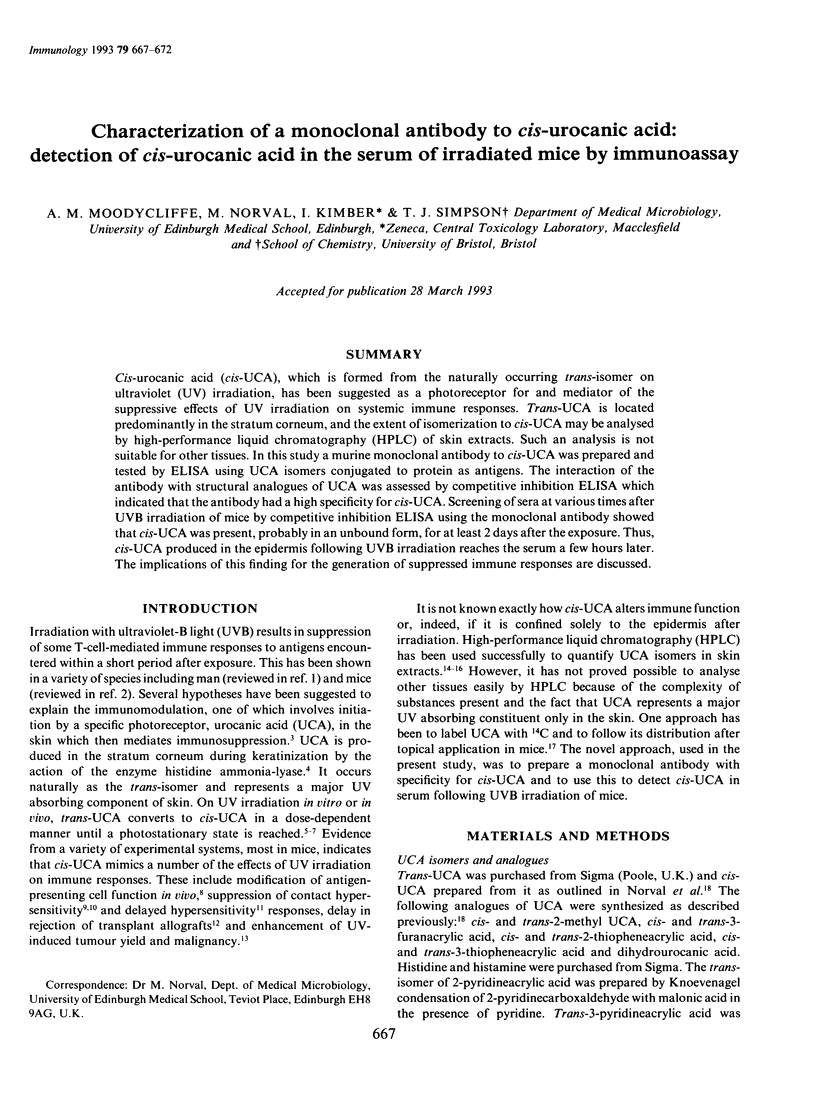
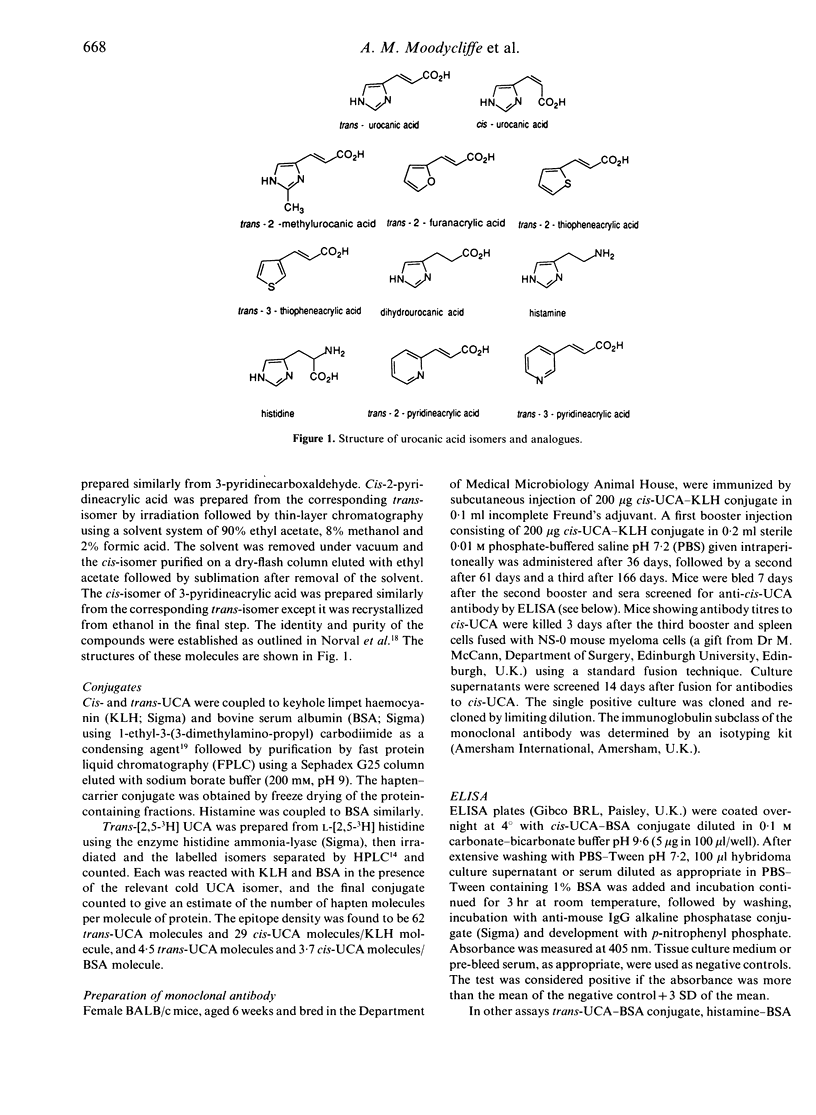
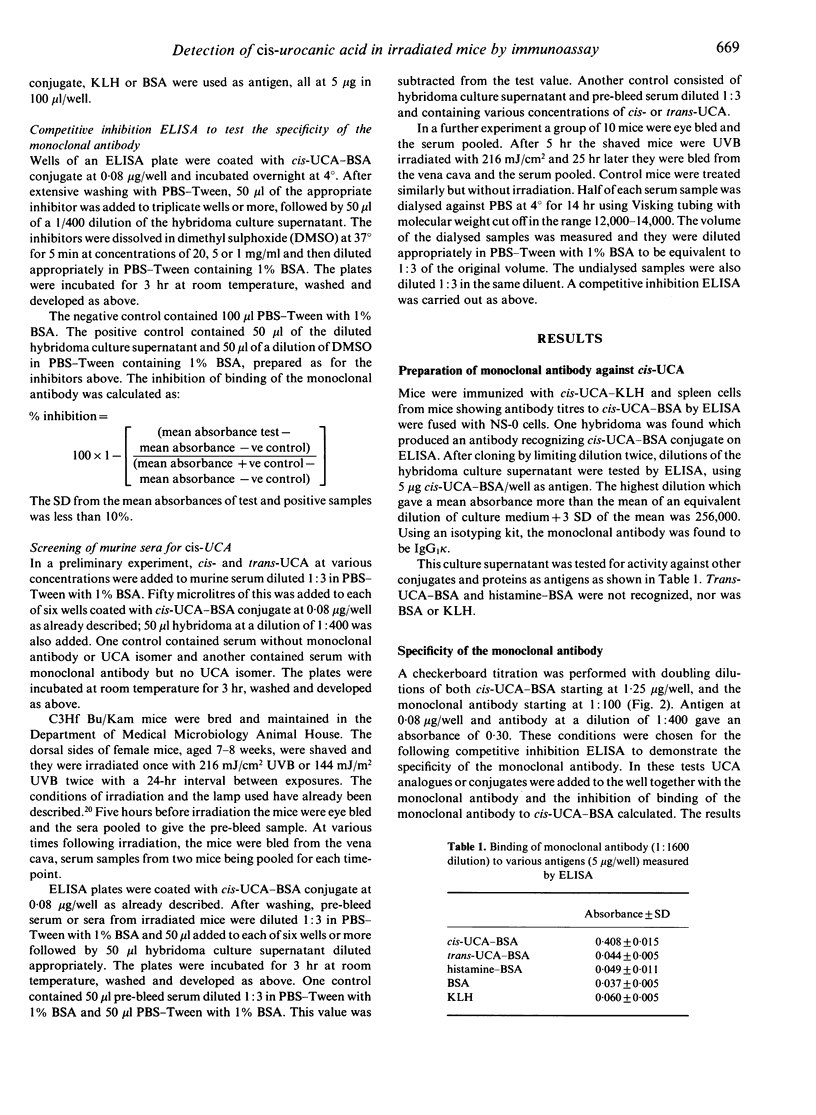
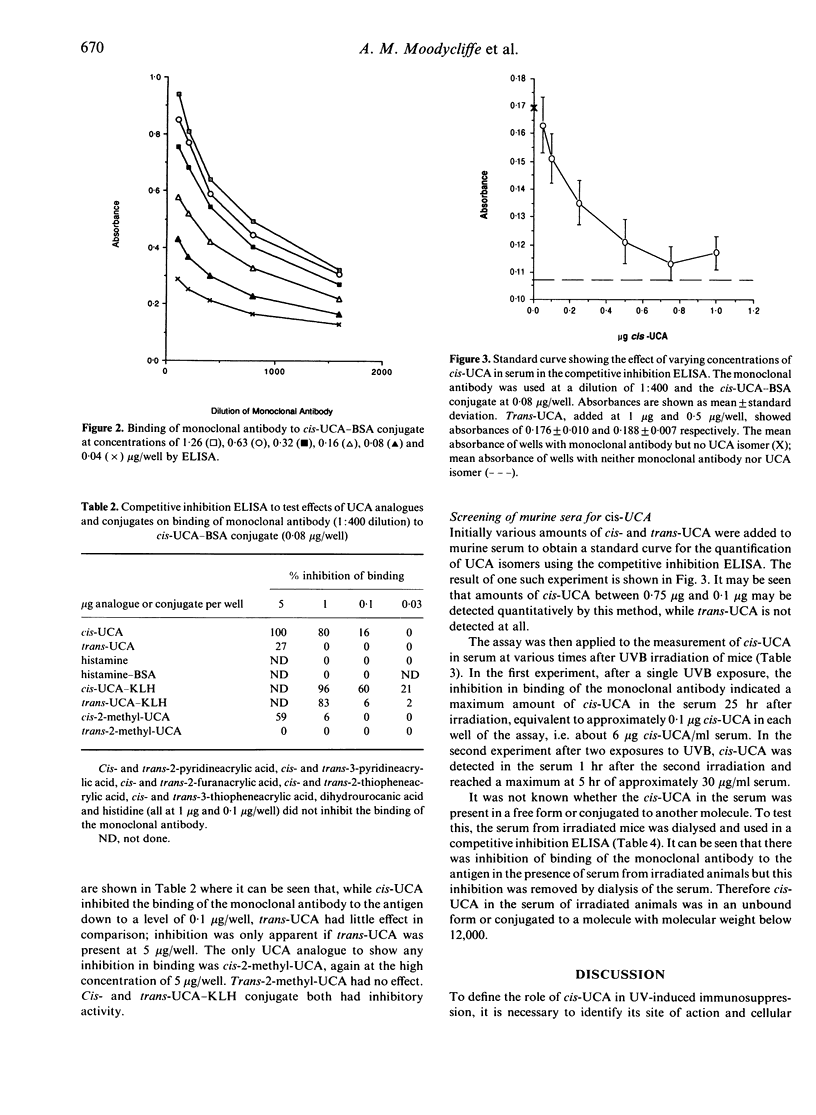
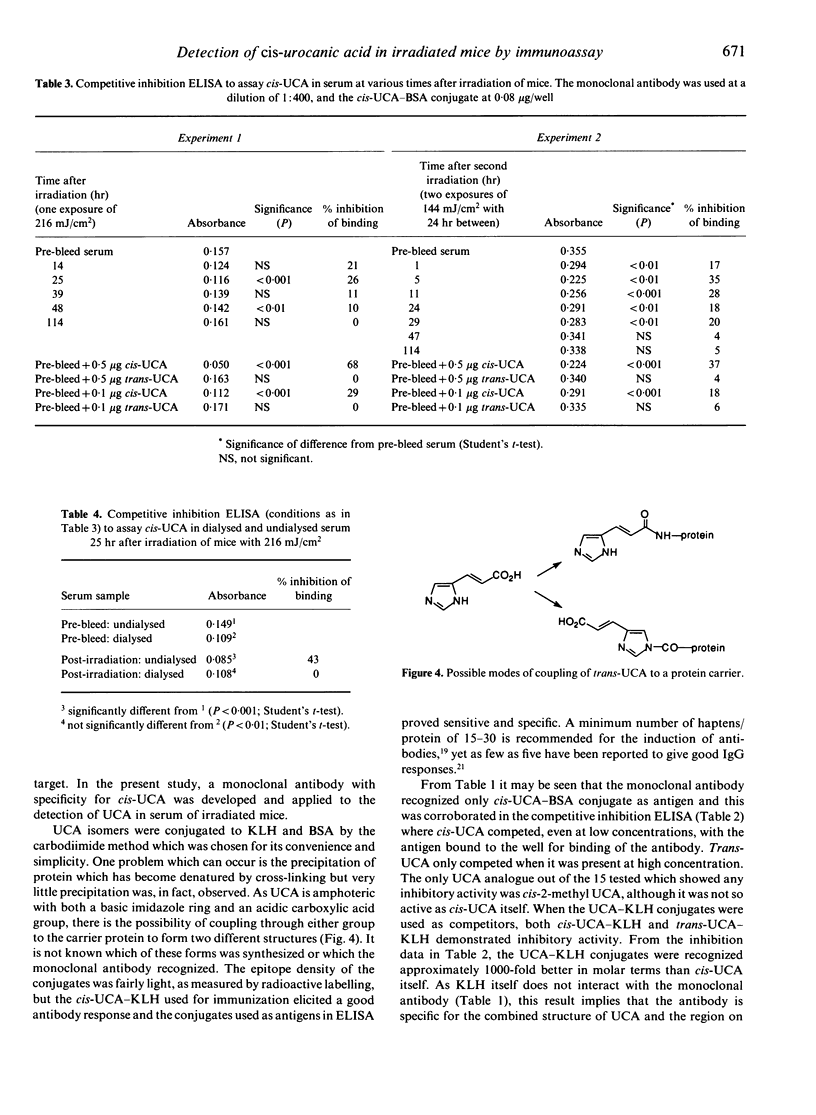
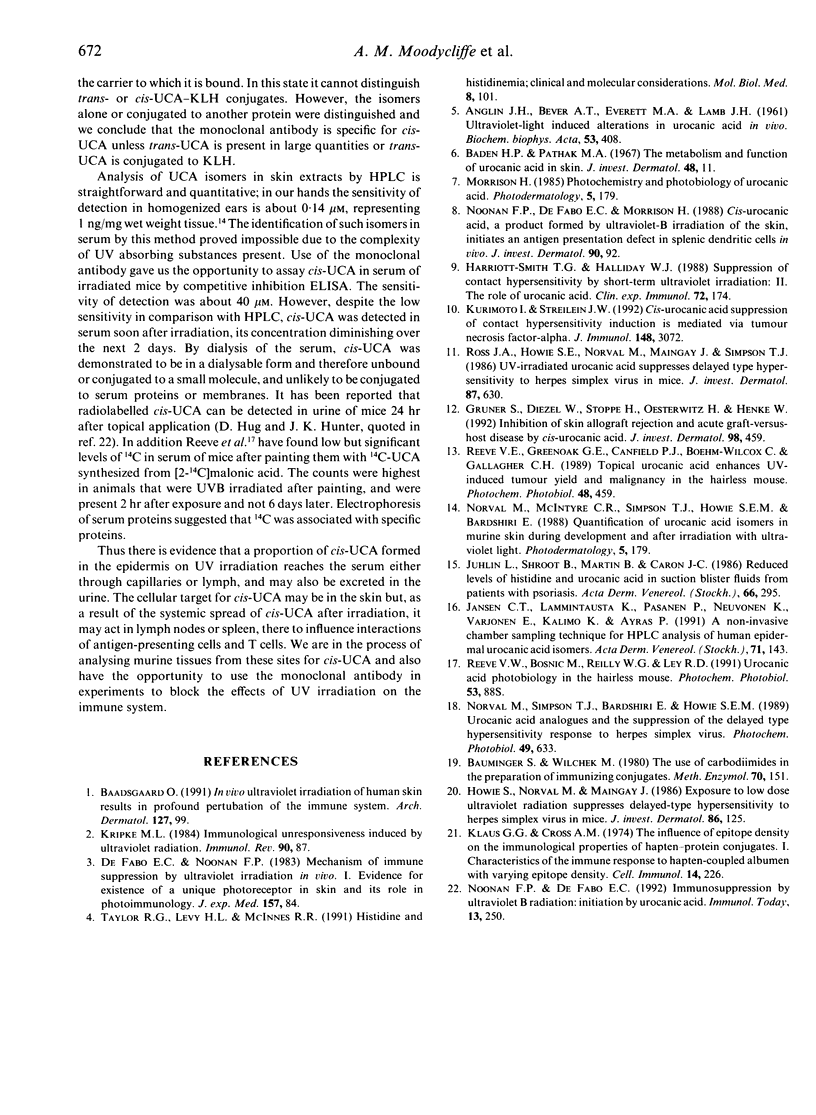
Selected References
These references are in PubMed. This may not be the complete list of references from this article.
- ANGLIN J. H., Jr, BEVER A. T., EVERETT M. A., LAMB J. H. Ultraviolet-light-induced alterations in urocanic acid in vivo. Biochim Biophys Acta. 1961 Oct 28;53:408–409. doi: 10.1016/0006-3002(61)90454-1. [DOI] [PubMed] [Google Scholar]
- Baadsgaard O. In vivo ultraviolet irradiation of human skin results in profound perturbation of the immune system. Relevance to ultraviolet-induced skin cancer. Arch Dermatol. 1991 Jan;127(1):99–109. [PubMed] [Google Scholar]
- Baden H. P., Pathak M. A. The metabolism and function of urocanic acid in skin. J Invest Dermatol. 1967 Jan;48(1):11–17. [PubMed] [Google Scholar]
- Bauminger S., Wilchek M. The use of carbodiimides in the preparation of immunizing conjugates. Methods Enzymol. 1980;70(A):151–159. doi: 10.1016/s0076-6879(80)70046-0. [DOI] [PubMed] [Google Scholar]
- De Fabo E. C., Noonan F. P. Mechanism of immune suppression by ultraviolet irradiation in vivo. I. Evidence for the existence of a unique photoreceptor in skin and its role in photoimmunology. J Exp Med. 1983 Jul 1;158(1):84–98. doi: 10.1084/jem.158.1.84. [DOI] [PMC free article] [PubMed] [Google Scholar]
- Gruner S., Diezel W., Stoppe H., Oesterwitz H., Henke W. Inhibition of skin allograft rejection and acute graft-versus-host disease by cis-urocanic acid. J Invest Dermatol. 1992 Apr;98(4):459–462. doi: 10.1111/1523-1747.ep12499855. [DOI] [PubMed] [Google Scholar]
- Harriott-Smith T. G., Halliday W. J. Suppression of contact hypersensitivity by short-term ultraviolet irradiation: II. The role of urocanic acid. Clin Exp Immunol. 1988 Apr;72(1):174–177. [PMC free article] [PubMed] [Google Scholar]
- Howie S., Norval M., Maingay J. Exposure to low-dose ultraviolet radiation suppresses delayed-type hypersensitivity to herpes simplex virus in mice. J Invest Dermatol. 1986 Feb;86(2):125–128. doi: 10.1111/1523-1747.ep12284128. [DOI] [PubMed] [Google Scholar]
- Jansén C. T., Lammintausta K., Pasanen P., Neuvonen K., Varjonen E., Kalimo K., Ayräs P. A non-invasive chamber sampling technique for HPLC analysis of human epidermal urocanic acid isomers. Acta Derm Venereol. 1991;71(2):143–145. [PubMed] [Google Scholar]
- Juhlin L., Shroot B., Martin B., Caron J. C. Reduced levels of histidine and urocanic acid in suction blister fluids from patients with psoriasis. Acta Derm Venereol. 1986;66(4):295–300. [PubMed] [Google Scholar]
- Klaus G. G., Cross A. M. The influence of epitope density on the immunological properties of hapten-protein conjugates. I. Characteristics of the immune response to hapten-coupled albumen with varying epitope density. Cell Immunol. 1974 Nov;14(2):226–241. doi: 10.1016/0008-8749(74)90208-1. [DOI] [PubMed] [Google Scholar]
- Kripke M. L. Immunological unresponsiveness induced by ultraviolet radiation. Immunol Rev. 1984 Aug;80:87–102. doi: 10.1111/j.1600-065x.1984.tb00496.x. [DOI] [PubMed] [Google Scholar]
- Kurimoto I., Streilein J. W. cis-urocanic acid suppression of contact hypersensitivity induction is mediated via tumor necrosis factor-alpha. J Immunol. 1992 May 15;148(10):3072–3078. [PubMed] [Google Scholar]
- Noonan F. P., De Fabo E. C. Immunosuppression by ultraviolet B radiation: initiation by urocanic acid. Immunol Today. 1992 Jul;13(7):250–254. doi: 10.1016/0167-5699(92)90005-R. [DOI] [PubMed] [Google Scholar]
- Noonan F. P., De Fabo E. C., Morrison H. Cis-urocanic acid, a product formed by ultraviolet B irradiation of the skin, initiates an antigen presentation defect in splenic dendritic cells in vivo. J Invest Dermatol. 1988 Feb;90(2):92–99. doi: 10.1111/1523-1747.ep12462045. [DOI] [PubMed] [Google Scholar]
- Norval M., McIntyre C. R., Simpson T. J., Howie S. E., Bardshiri E. Quantification of urocanic acid isomers in murine skin during development and after irradiation with UVB light. Photodermatol. 1988 Aug;5(4):179–186. [PubMed] [Google Scholar]
- Norval M., Simpson T. J., Bardshiri E., Howie S. E. Urocanic acid analogues and the suppression of the delayed type hypersensitivity response to Herpes simplex virus. Photochem Photobiol. 1989 May;49(5):633–639. doi: 10.1111/j.1751-1097.1989.tb08435.x. [DOI] [PubMed] [Google Scholar]
- Reeve V. E., Greenoak G. E., Canfield P. J., Boehm-Wilcox C., Gallagher C. H. Topical urocanic acid enhances UV-induced tumour yield and malignancy in the hairless mouse. Photochem Photobiol. 1989 Apr;49(4):459–464. doi: 10.1111/j.1751-1097.1989.tb09195.x. [DOI] [PubMed] [Google Scholar]
- Ross J. A., Howie S. E., Norval M., Maingay J., Simpson T. J. Ultraviolet-irradiated urocanic acid suppresses delayed-type hypersensitivity to herpes simplex virus in mice. J Invest Dermatol. 1986 Nov;87(5):630–633. doi: 10.1111/1523-1747.ep12456257. [DOI] [PubMed] [Google Scholar]
- Taylor R. G., Levy H. L., McInnes R. R. Histidase and histidinemia. Clinical and molecular considerations. Mol Biol Med. 1991 Feb;8(1):101–116. [PubMed] [Google Scholar]


